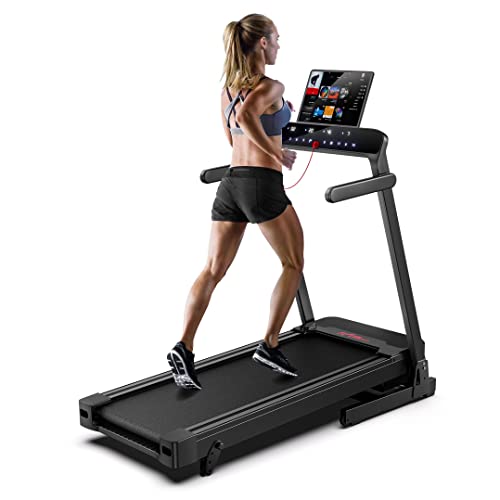Your Family Will Be Thankful For Getting This Walking Machine

The Walking Machine: A Comprehensive Guide to Your Fitness Companion
In today's fast-paced world, where time is a high-end, preserving a constant workout routine can be a difficulty. For numerous, a walking machine-- commonly called a treadmill-- works as a perfect fitness buddy. This post supplies a thorough appearance at walking machines, including their benefits, types, maintenance suggestions, and regularly asked questions.
Why Choose a Walking Machine?
Walking machines use a practical and reliable way to integrate cardiovascular exercise into everyday life. Here are a number of essential advantages:
- Convenience: Walking machines allow individuals to exercise anytime, regardless of weather conditions or time constraints. They are best for busy schedules.
- Adaptability: Users can stroll, jog, or perform at their own rate and intensity.
- Security: Walking machines present a lower danger of injury compared to outside walking or running, specifically for newbies or those recuperating from injuries.
- Tracking Progress: Many treadmills included built-in displays that track metrics like speed, range, and calories burned.
Kinds Of Walking Machines
When thinking about a walking machine, it's vital to select the best type based on individual physical fitness goals and area restrictions. Below are the main types of walking machines:
| Type | Description |
|---|---|
| Handbook Treadmills | These machines do not have a motor, and users need to walk or go to rotate the belt. |
| Electric Treadmills | Powered by an electric motor, permitting users to set the speed and slope effortlessly. |
| Folding Treadmills | Developed for simple storage, these treadmills can be folded up when not in usage. |
| Desk Treadmills | Suitable for a double work and workout environment, these compact machines enable walking while working. |
| Slope Trainers | These allow users to replicate uphill walking, enhancing exercise strength and calorie burn. |
Choosing the Right Walking Machine
Choosing the best walking machine can considerably impact motivation and efficiency. Here are some elements to consider:
Key Features to Look For
- Motor Power: An effective motor makes sure a smooth and consistent workout. For periodic walkers, a 1.5 HP motor is typically adequate; for heavier usage, try to find 3.0 HP and above.
- Belt Size: A larger and longer belt supplies more space for a comfy stride. Requirement sizes range from 16 inches wide and 50 inches long.
- Slope Options: Adjustable slope settings can replicate walking or running uphill, increasing the strength of the workout.
- Shock Absorption: Good shock absorption decreases the danger of joint injuries and improves comfort.
- Console Features: Look for integrated exercises, heart rate screens, and connection features like Bluetooth for a more interesting experience.
Spending plan Considerations
Walking machines been available in a broad variety of rates, depending on features and building and construction quality. Here's a rough spending plan breakdown:
| Price Range | Functions |
|---|---|
| Under ₤ 300 | Standard manual or small electric treadmills with minimal features. |
| ₤ 300 - ₤ 700 | More advanced electric treadmills with slope, medium power motors, and better service warranties. |
| ₤ 700 - ₤ 1500 | Premium electric treadmills with larger built-in display screens, comprehensive features, and warranties. |
| ₤ 1500 and above | High-end designs using sophisticated technology, features, and long lasting building and construction for major fitness enthusiasts. |
Maintenance Tips for Your Walking Machine
To guarantee longevity and optimum performance of a walking machine, consider the following upkeep ideas:
- Regular Cleaning: Dust and sweat can collect on the machine and the belt. Clean down the surface areas and tidy the belt regularly.
- Lubrication: Depending on the model, lubricating the running belt periodically can avoid wear and tear. Check you could try here for recommended lubrication schedules.
- Inspection: Periodically examine the machine for loose screws or worn parts. Tighten and replace as required.
- Calibration: Occasionally, inspect the calibration of your machine's metrics to guarantee they supply accurate data.
- Appropriate Use: Follow the producer's suggestions for weight limitations and functional guidelines.
FAQs About Walking Machines
1. Are walking machines a good workout?
Yes, walking machines supply an excellent cardiovascular workout, can assist with weight-loss, and improve overall health.
2. How frequently should I utilize a walking machine?
Aim for a minimum of 150 minutes of moderate-intensity aerobic activity each week, which can easily be attained with routine sessions on a walking machine.
3. Can I reduce weight on a walking machine?
Yes, including a walking machine regimen into a healthy diet can promote weight loss, particularly if integrated with periods and incline training.
4. Is it safe for elders to utilize a walking machine?
Yes, walking machines can be safe for seniors with low-impact settings and safety features like hand rails. However, individuals must seek advice from their healthcare company before beginning any workout program.
5. What's the distinction in between a treadmill and a walking machine?
The term "walking machine" usually describes a treadmill meant for walking, while "treadmill" can refer to machines utilized for numerous strengths, including running.
With their versatility and convenience, walking machines can significantly enhance one's fitness journey. By carefully picking the ideal type, making sure appropriate maintenance, and integrating various workout techniques, users can maximize their walking machine's benefits. As with any workout program, consistency is crucial to accomplishing lasting physical fitness outcomes.

